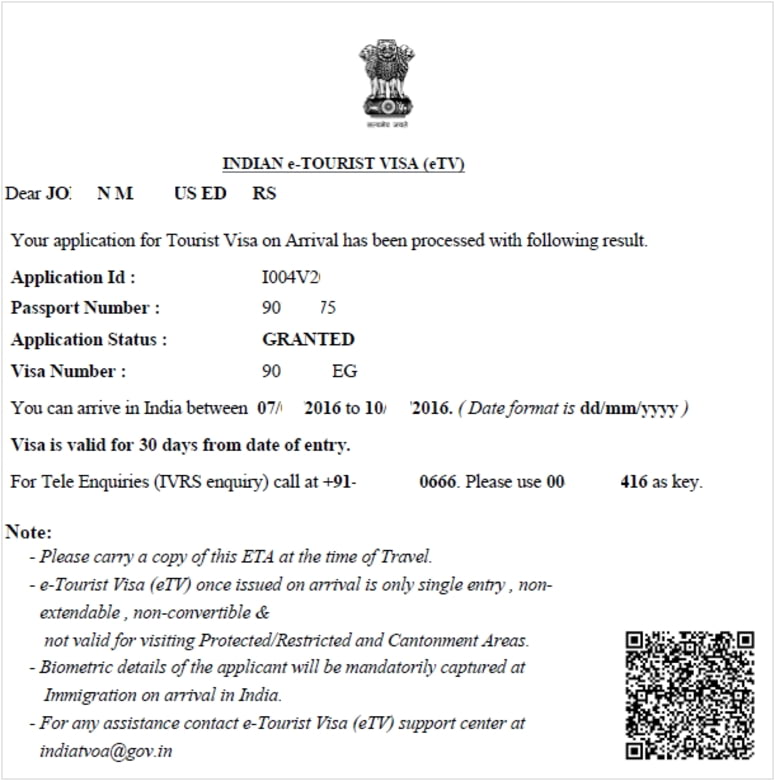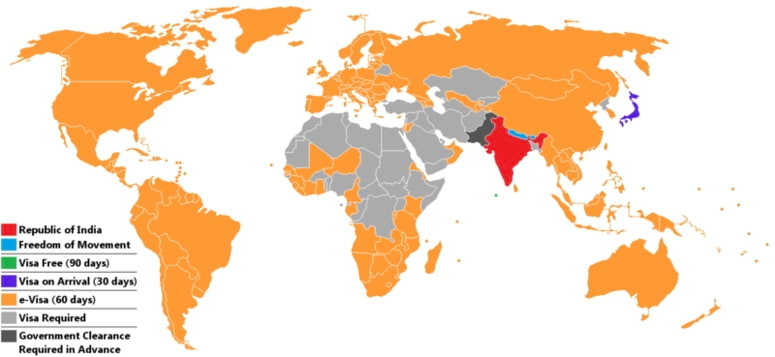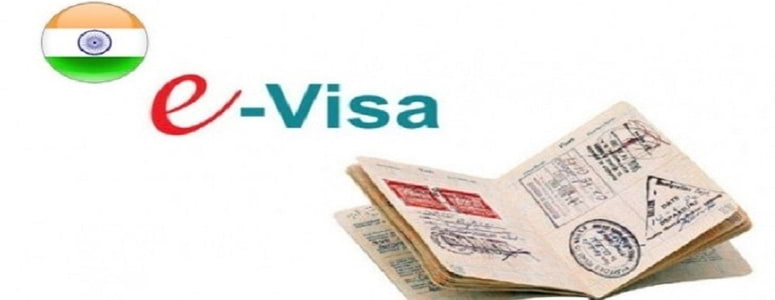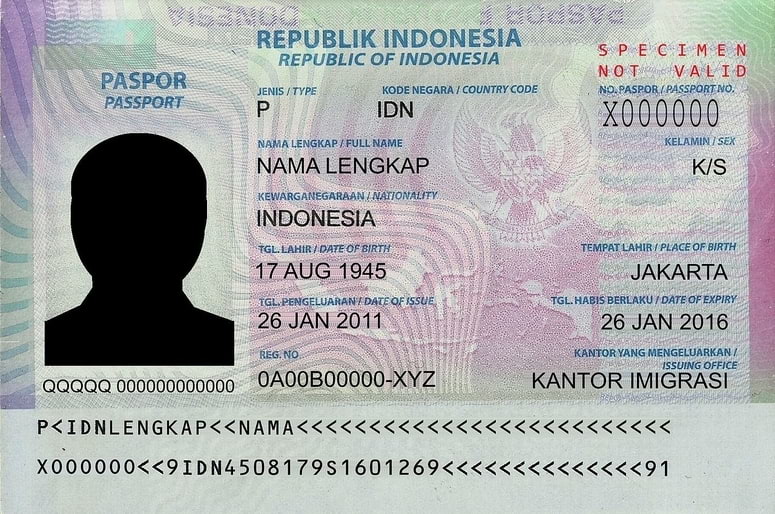Until a couple of years ago, travelers had to make rounds of Indian embassy or consulate in their countries to apply for a tourist visa to travel in India. Obtaining a tourist visa was a real hassle with the amount of paperwork, visits to embassy/consulate, and time concerns. 3 years ago Indian Prime Minister Narendra Modi announced an e-Visa policy for tourists wanting to visit India. Since his announcement, the visa procedure has been quick and easy. The number of foreign travelers has gone up and applicants have had a pleasant experience with the e-Visa procedure.
What is an e-Visa?
Rather than visiting Indian embassy/consulate in your country, now you apply for a visa online at Official India e-Visa Website. The steps are clearly stated on the website. But, for the readers, I will break down the basics of the visa procedure. First, you will register on the official India e-Visa Website. After registration, you will fill out the e-Visa application form and upload necessary documents with the application form. Next step is to pay the visa fee based on your country. After you have paid the visa fee, you will get an Electronic Travel Authorization (ETA) within 4-7 days. If your ETA is granted (this means your e-Visa application is approved), then you should print the ETA you received in email and carry it with you when you travel to India. The ETA is your e-Visa and you will have to show it to the immigration authorities when you land in India.

India eVisa Approval Letter Sample
Who should apply for an e-Visa?
Currently, e-Visa has 3 sub-categories – e-Tourist visa, e-Business Visa, and e-Medical visa. If you are traveling to India for one of the above-mentioned purposes then you can apply for an e-Visa. For this article, we will only cover e-Tourist visa. Another thing to consider is how long you want to spend in India. The Indian e-Tourist visa is valid for 60 days from the date of arrival, therefore if you intend to spend longer than 60 days in India, you should apply for a traditional tourist visa. The e-Visa only allows two entries within the 60 day period. Hence, if you plan on entering India more than two times, then you should apply for a traditional multiple entry tourist visa.
Who can apply for an e-Visa?
Citizens of following countries can apply for an e-Visa:
Albania, Andorra, Angola, Anguilla, Antigua & Barbuda, Argentina, Armenia, Aruba, Australia, Austria, Azerbaijan, Bahamas, Barbados, Belgium, Belize, Bolivia, Bosnia & Herzegovina, Botswana, Brazil, Brunei, Bulgaria, Burundi, Cambodia, Cameron Union Republic, Canada, Cape Verde, Cayman Island, Chile, China, China- SAR Hongkong, China- SAR Macau, Colombia, Comoros, Cook Islands, Costa Rica, Cote d’lvoire, Croatia, Cuba, Cyprus, Czech Republic, Denmark, Djibouti, Dominica, Dominican Republic, East Timor, Ecuador, El Salvador, Eritrea, Estonia, Fiji, Finland, France, Gabon, Gambia, Georgia, Germany, Ghana, Greece, Grenada, Guatemala, Guinea, Guyana, Haiti, Honduras, Hungary, Iceland, Indonesia, Ireland, Israel, Italy, Jamaica, Japan, Jordan, Kenya, Kiribati, Laos, Latvia, Lesotho, Liberia, Liechtenstein, Lithuania, Luxembourg, Madagascar, Malawi, Malaysia, Mali, Malta, Marshall Islands, Mauritius, Mexico, Micronesia, Moldova, Monaco, Mongolia, Montenegro, Montserrat, Mozambique, Myanmar, Namibia, Nauru, Netherlands, New Zealand, Nicaragua, Niger Republic, Niue Island, Norway, Oman, Palau, Palestine, Panama, Papua New Guinea, Paraguay, Peru, Philippines, Poland, Portugal , Republic of Korea, Republic of Macedonia, Romania, Russia, Rwanda, Saint Christopher and Nevis, Saint Lucia, Saint Vincent & the Grenadines, Samoa, San Marino, Senegal, Serbia, Seychelles, Sierra Leone, Singapore, Slovakia, Slovenia, Solomon Islands, South Africa, Spain, Sri Lanka, Suriname, Swaziland, Sweden, Switzerland, Taiwan, Tajikistan, Tanzania, Thailand, Tonga, Trinidad & Tobago, Turks & Caicos Island, Tuvalu, UAE, Ukraine, United Kingdom, Uruguay, USA, Uzbekistan, Vanuatu, Vatican City-Holy See, Venezuela, Vietnam, Zambia and Zimbabwe.

Citizens from countries in yellow can apply for an eVisa
When should you apply for an Indian tourist e-Visa?
According to the official website “may apply online minimum 4 days in advance of the date of arrival with a window of 120 days. Example: If you are applying on 1st Sept then the applicant can select arrival date from 5th Sept to 2nd Jan”.
But, it is better to apply at least 2 weeks before you plan to travel to India
What are the requirements for the Indian tourist e-Visa?
The requirements for the e-Visa online application are:
- Biopage of Passport containing personal details like name, date of birth, nationality, expiry date etc. The passport must have at least six months validity from the intended date of arrival in India and at least two blank pages
- Recent front-facing photograph with white background
- Return ticket or onward journey ticket, with sufficient money to spend during your stay in India [Not required for the application. But, required to enter India when traveling]
- Yellow Fever Vaccination Card is mandatory at the time of arrival for citizens of following countries:Angola, Argentina, Benin,Bolivia, Brazil, Burkina Faso, Burundi, Cameroon,Central African Republic, Chad, Colombia, Congo, Cote d’Ivoire, Democratic Republic of Congo, Ecuador, Equatorial Guinea, Ethiopia, French Guyana, Gabon, Gambia, Ghana, Guinea, Guinea-Bissau, Guyana, Kenya, Liberia, Mali, Mauritania, Niger, Nigeria, Panama, Paraguay, Peru, Rwanda, Senegal, Sierra Leone, Sudan, Suriname, South Sudan, Togo, Trinidad and Tobago, Uganda, and Venezuela
How long is the Indian e-Visa valid for?
The Indian e-Visa is valid for 60 days from the date of the first arrival. It is a double-entry visa, which means after your first entry you can still enter India one more time within the 60 day period.
Is the Indian e-Visa extendable beyond the 60 days?
No, you can’t extend your visa beyond the 60 days. What you can do is apply for another tourist e-Visa. You can apply for a tourist e-Visa twice within a calendar year
Can you apply for the second tourist e-Visa within a calendar year while still being in India?
Yes and no. Yes because you do the e-Visa procedure while being in India and you can even receive the e-Visa by email (if Granted). But, the e-Visa doesn’t start until you enter India from one of the authorized port of entries. What most travelers do is that after receiving their e-Visa they travel to a neighboring country like Nepal, Bangladesh, or Sri Lanka and then fly back to one of the authorized airports. This gets you an additional 60 days in India.
What are the authorized port of entries that one can enter with an e-Visa?
Airports: Ahmedabad, Amritsar, Bagdogra, Bengaluru, Calicut, Chennai, Chandigarh, Cochin, Coimbatore, Delhi, Gaya, Goa, Guwahati, Hyderabad, Jaipur, Kolkata, Lucknow, Mangalore, Mumbai, Nagpur, Pune, Tiruchirapalli, Trivandrum & Varanasi
Seaports: Cochin, Goa, Mangalore
e-Visa is not valid to enter India via land. Although, you can use any authorized Immigration Check Posts (ICPs) to exit India
What is the e-Visa fee?
The e-Visa fee depends on what country you belong to. You can find out to respective visa fee. Payments can be made using Credit and Debit Cards issued by MasterCard and VISA.
Note: The e-visa fee is non-refundable regardless of whether you are granted the e-visa or not.
Official India e-Visa Website: https://indianvisaonline.gov.in/evisa/tvoa.html
Official India e-Visa Helpline: +91-11-24300666
Official India e-Visa Email: indiatvoa@gov.in
If you have any questions regarding Indian tourist e-Visa feel free to ask in the comments below. Thanks for reading the article and happy travels in India.

